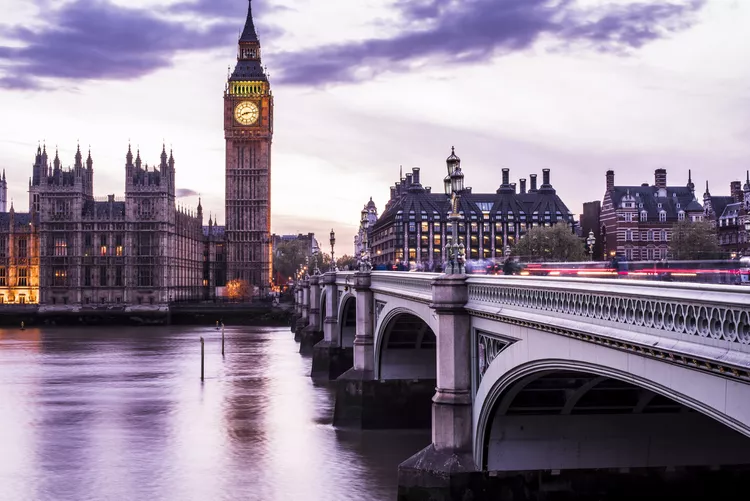Summary
London has many public transportation options, and most tourists do not drive in the city. Not only is there limited parking and lots of congestion, but in London, you also have to contend with left-side driving, which isn’t always easy. Should you choose to drive in London, here’s what you need to know about the documents required, congestion issues, basic rules of the road, and of course, how to find parking.
Driving Requirements
There are several legal requirements in place to get behind the wheel in London—abide by them, or risk getting ticketed.
Checklist for Driving in London:
- Driving License: A valid driving license is required to drive in the UK, and non-UK driving licenses are acceptable for up to 12 months from when you first entered the UK.
- Passport: Almost all car rental companies require a passport or some form of official photographic ID to rent a car. Some may also ask for proof of address in the UK (hotel confirmation) and travel documents (i.e., airline tickets confirming your UK departure date).
- Insurance: UK law requires a valid motor vehicle insurance certificate. If renting, verify that all drivers are properly insured under this agreement and ensure you have all the necessary paperwork.
- International Driving Permit: An International Driving Permit (IDP) is not officially required for US-license holders in the UK, though some rental companies do require it; thus, it’s recommended.
Rules of the Road
Driving in London isn’t easy. If possible, visually familiarize yourself with the road signs ahead of time. You can find images of many of them here. Here are the key rules:
- Left-side driving: Drive on the left side of the road at all times. Consider getting a vehicle with an automatic transmission to ease the transition.
- Seatbelts: Safety belts must be worn at all times.
- Mobile Phone: Like in the US, using a mobile phone while driving is illegal in the UK (except in emergencies when dialing 112 or 999).
- Speed Limits: Speed limits are listed in kilometers (1 mile = 1.61 kilometers), and speed cameras enforce these limits on some roads.
- BAC: The blood alcohol content limit is the same as in the US (0.08%).
- Pedestrian crossings: London is busy, so watch for pedestrians, cyclists, and motorcyclists. Yield to pedestrians at marked zebra crossings.
- Bike lanes: Be cautious of bike lanes and cyclists. Always look before opening your car door.
- Bus lanes: Bus lanes are indicated by a thick white line. These lanes are reserved during certain hours.
- Yellow box junctions: Do not stop within yellow box junctions; these are designed to avoid traffic jams and make way for emergency vehicles.
- Congestion charges: If driving in central London during peak hours (7 a.m.-6 p.m., Monday to Friday), prepay a daily Congestion Charge of £11.50. Payment methods include online, autopay, or telephone. The zones are marked with a sign displaying the letter “C” in a red circle.
- Motorways: There is no fast lane; the left lane should only be used for overtaking.
- Roundabouts: Traffic flows clockwise; yield to traffic approaching from your right and use indicators to signal your exit.
- Fuel: Gas is referred to as petrol in London. You’ll find diesel at stations as well. The pumps are usually green for petrol and black for diesel.
- In case of an emergency: Call 112 or 999 for emergency services. If you’re involved in an accident with injuries or damage, you’re required to stop.
- Tolls: There is only one tollgate in London, located on a private section of College Road in Dulwich. All cars must pay a £1.20 toll, either by cash or card.
- Traffic: Avoid driving during rush hour (6-10 a.m. and 4-6:30 p.m.).
- For additional information on London’s traffic laws, refer to the official Highway Code.
Parking in London
Finding street parking in London can be quite challenging. Always check street signs to avoid fees, as there may be time limits or residential permits required. Many streets have parking restrictions in place between 8:30 a.m. and 6:30 p.m., Monday to Saturday. A pay and display system is common, requiring you to buy a ticket from a nearby machine.
Be vigilant for yellow and red lines along the curb, indicating no parking or waiting. The yellow lines control waiting. Red lines mean no stopping at any time, often designated as “red routes.” Failure to follow these rules may result in a Penalty Charge Notice (PCN).
To avoid street parking, consider using a designated parking lot. Qpark has facilities at the edges of congestion zones, including locations like Park Lane/Marble Arch, Queensway, and more. They have 18 total parking lots, and prices vary based on time and location.
Traffic in London
Traffic congestion is a common issue in London, much like any major city. For month-by-month updates on planned works that could impact transport, including driving, check here. It’s wise to plan alternative routes in case of unexpected diversions and always allow extra time for travel.
Transport for London (TfL) also provides live status updates on road closures and delays, including expected conditions for the weekend and future dates. Expect significant traffic disruptions around holidays (such as Christmas) and bank holidays.
Should You Rent A Car In London?
Generally, renting a car in London is not recommended, barring special circumstances like mobility issues. With ample public transportation options, including the Underground and buses, visitors can navigate the city easily. However, London is expansive and, moving away from the city center, public transport connections grow sparse. As such, some tourists might find a rental car a suitable option, especially to explore the countryside. It’s essential to familiarize yourself with local driving tips to ensure a safe experience.





